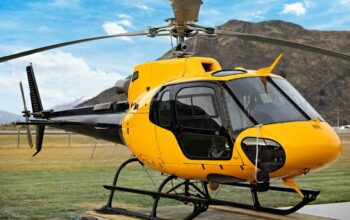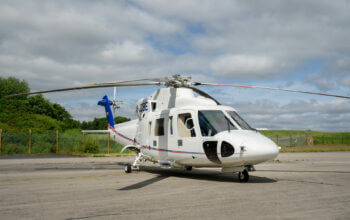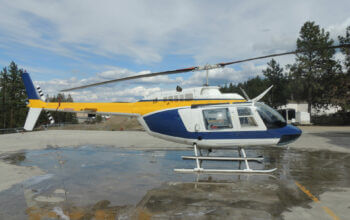Bell is targeting new sales and support growth in a buoyant Australian helicopter market, with the acquisition of Eagle Copters Maintenance (ECM) — now known as Bell Textron Australia — helping to drive it.
The acquisition of ECM in July 2022 represented a substantial investment in the country, Grant Boyter, director of strategic business development at Bell Textron Australia, told Vertical.
ECM — based in Coffs Harbour, New South Wales — had acquired maintenance, repair and overhaul (MRO) specialist Heliwork, located in Redcliffe, Queensland, in 2019. This had doubled its staff count and taken the footprint of the combined facilities to over 30,000 square feet.
As well as more heavy maintenance capabilities, Heliwork provided additional completion/customization expertise. And while ECM had focused on Bell medium airframes, Heliwork had built a reputation for MRO on a diverse set of types.
According to Boyter, Bell has been keen to ensure the variety of operations remains unchanged at both Bell Textron Australia locations.
“We’ve changed the sign on the front of the of the hangar, and then that’s it,” he said. “As far as customers are concerned — especially the non-Bell customers — we wanted them to know that we’re still going to be running down the same road. We’ve even made investments into some non-Bell areas, such as in tooling and training.”
As for Bell customers, Sonia Fuller, general manager of Bell Textron Australia, said they are “experiencing the ability to get more services and have greater support.”
The roadmap for Bell Textron Australia will include a greater amount of complex MRO and completion work.
“We’ve already got some good miles in doing [AW]139 bespoke EMS [emergency medical services completions],” said Boyter. “Along with that, we’ve done a lot of similar type [completions] on Bell 412s — and the whole Bell range, to be honest — meeting all types of configurations within Australia.”
In addition to Bell Textron Australia’s facilities in Redcliffe and Coffs Harbour, the OEM’s footprint in Australia and New Zealand includes certified customer service facilities Heliwest (Perth, Western Australia), Jet Aviation (Sydney, New South Wales), and Salus Aviation (Auckland, New Zealand). Through a joint venture with Jet Aviation, it also has a rotor blade repair shop — RBI Hawker — in Brisbane, Queenland.
All of these are backed by Bell’s main support hub in the region in Singapore, which carries thousands of line items in spares.
There are over 400 Bell aircraft in Australia, but as well as supporting the legacy fleet, Bell is targeting new aircraft tenders for law enforcement and firefighting agencies.
“We’re seeing good success with the Bell 429, [and] we’ve had a number of new Bell 407s coming into the country as well that do tourism, utility and powerline survey [work],” said Daniel McQuestin, Bell’s business development director for Australia, New Zealand and the Pacific Rim. “We’ve seen that those aircraft have gone straight out to work and been very reliable working in remote environments, [with] very high hours.”
An Unusual Market
Boyter described the Australian market as “unusual,” with some growth areas that are keeping most operators busy. Airborne law enforcement and firefighting are two big areas of development, with police forces looking to expand and fire agencies buying their own aircraft or giving out more contracts.
“There’s a lot of people going for [Leonardo] AW139s in the EMS market, and the [Bell] 412s are coming out of there and at the moment a lot of them are going into firefighting,” he said. “There’s a lot of work, and we’re just trying to keep ahead of that to see where the trends are going and trying to meet the market.”
Looking at future opportunities for Bell, he said Australia’s North West shelf oil-and-gas region could be well suited to the 525 Relentless when the long-awaited super medium is certified.
In terms of new aircraft sales, McQuestin said Australia has seen “a bit of a tail off after a big couple of years,” with most recent growth being government-driven — as well as some uptick in the oil-and-gas sector.
“In the private sector, we’re just seeing some of the cost of living pressures and things putting a bit of pressure down on some of the private buyers,” he said.
However, McQuestin also cautioned about the impact being felt across the industry by a shrinking pool of qualified engineers and pilots — and this was echoed by Fuller.
“We’re looking at making sure that we get out to schools and talk to those folks who are coming up to leaving school, getting engaged in career expos [and] post-school options,” she said.
“That’s one of the things I’m focusing on over the next little while. We’ve got capability that we’re trying to expand, but nothing can happen without the right people.”
Another area of concern is getting the needed spares and parts with the ongoing supply chain issues affecting the industry. “We’re just looking for innovative ways to try and cover that with used parts or dismantling components . . . to make sure that we satisfy and service the customers,” said Boyter.
“Bell has a long legacy of support, and there’s a lot of staff running around in the background there trying to solve these issues and looking for innovative ways to do it. And I think they’ve done a great job and we’ve been part of that, especially with our overhauls. We’ve gone out and purchased components and parted them out to try to keep them flying.”
Fuller said Bell is working to enhance its component repair and overhaul capability.
“I think the pressures around the industry are many and varied and we’re definitely running down that path of wanting to be a provider of aviation solutions,” she said. “How that fits with industry and customers and operators — we’re happy to look at anything that we can do to provide those solutions.”









